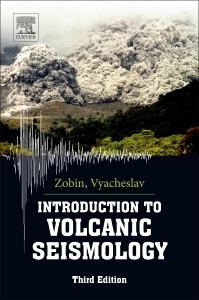Introduction to Volcanic Seismology (3rd Ed.) Developments in Volcanology Series
Auteur : Zobin Vyacheslav M

Introduction to Volcanic Seismology, Third Edition covers all aspects of volcano seismology, specifically focusing on recent studies and developments. This new edition expands on the historical aspects, including updated information on how volcanic seismology was handled in the past (instrumentation, processing techniques, number of observatories worldwide) that is compared to present day tactics. Updated case studies can be found throughout the book, providing information from the most studied volcanoes in the world, including those in Iceland.
Additional features include descriptions of analog experiments, seismic networks, both permanent and temporal, and the link between volcanoes, plate tectonics, and mantle plumes. Beginning with an introduction to the history of volcanic seismology, the book then discusses models developed for the study of the origin of volcanic earthquakes of both a volcano-tectonic and eruption nature.
In addition, the book covers a variety of topics from the different aspects of volcano-tectonic activity, the seismic events associated with the surface manifestations of volcanic activity, descriptions of eruption earthquakes, volcanic tremor, seismic noise of pyroclastic flows, explosion earthquakes, and the mitigation of volcanic hazards.
Chapter 1. Introduction
Chapter 2. Seismicity at Volcanoes
Chapter 3. Fundamentals of Volcanic Seismology
Chapter 4. Origin of Volcano-Tectonic Earthquakes
Chapter 5. Volcano-Tectonic Earthquakes at Basaltic Volcanoes: Case Studies
Chapter 6. Volcano-Tectonic Earthquakes at Andesitic Volcanoes: Case Studies
Chapter 7. Volcano-Tectonic Earthquakes at Dacitic Volcanoes: Case Studies
Chapter 8. General Properties of Volcano-Tectonic Earthquake Swarms
Chapter 9. Source Properties of Volcano-Tectonic Earthquakes
Chapter 10. Significant Volcano-Tectonic Earthquakes and Their Role in Volcanic Processes
Chapter 11. Origin of Eruption Earthquakes
Chapter 12. Volcanic Tremor
Chapter 13. Seismic Signals Associated With Pyroclastic Flows, Rockfalls, and Lahars
Chapter 14. Seismic Signals Associated With Volcanic Explosions
Chapter 15. Long-Period and Very-Long-Period Seismic Signals at Volcanoes
Chapter 16. Swarms of Microearthquakes Associated With Effusive and Explosive Activity at Volcanoes
Chapter 17. Acoustic Waves Generated by Volcanic Eruptions
Chapter 18. Seismic Monitoring of Volcanic Activity and Forecasting of Volcanic Eruptions
Chapter 19. Seismic Activity at Dormant Volcanic Structures: A Problem of Failed Eruption
Chapter 20. The Seismic Signals Associated With the Natural Seismicity of Geothermal Structures Within Volcanic Environment
- Presents updated global case studies to provide real-world applications, including studies from Iceland
- Delivers illustrations alongside detailed descriptions of volcanic eruptions
- Includes essential information that students and practitioners need to understand the essential elements of volcanic eruptions
- Updates include information on how volcanic seismology was handled in the past (instrumentation, processing techniques, number of observatories worldwide) that are compared to the tactics of today
Date de parution : 10-2016
Ouvrage de 582 p.
15.2x22.8 cm
Disponible chez l'éditeur (délai d'approvisionnement : 14 jours).
Prix indicatif 143,27 €
Ajouter au panierThème d’Introduction to Volcanic Seismology :
Mots-clés :
Acoustic waves; Andesitic volcano; Ascent of magma; Basaltic volcano; Classification of volcanic earthquakes; Complex frequency; Dacitic volcano; Dormant volcano; Earthquake swarm; Energy of explosion; Eruption earthquake; Explosion; Failed eruption; Focal mechanism; Forecasting of eruptions; Fourier spectrum; Geothermal system; Lahar; Lava dome collapse; Lava flow; Long-period seismic signal; Magma arrest; Magma fracturing; Magma; Microearthquake swarm; Model of volcano-tectonic earthquake sequ



